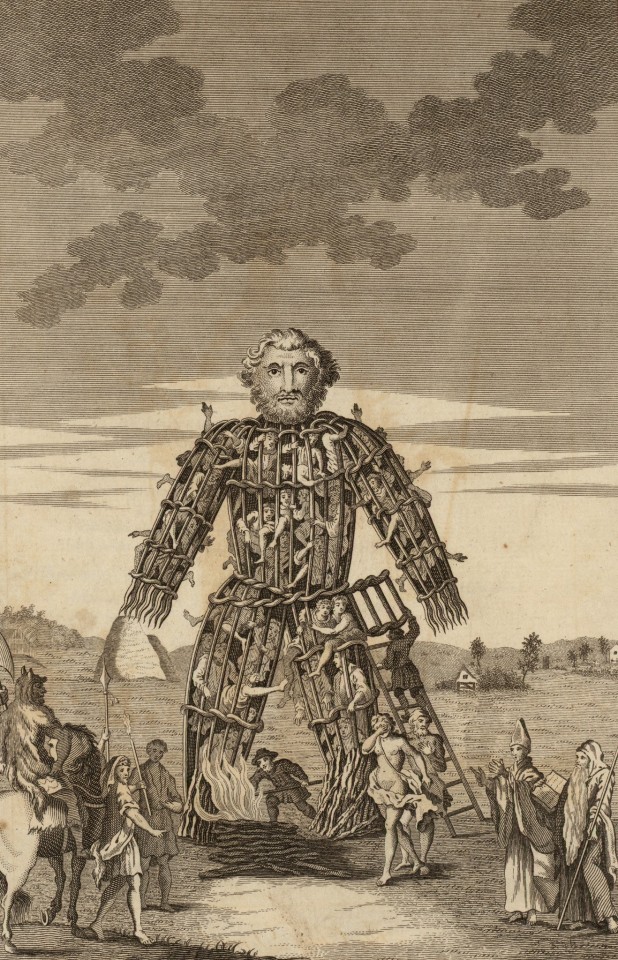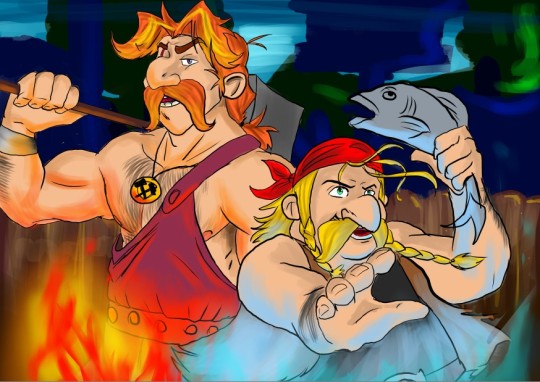#gauls
Explore tagged Tumblr posts
Text

The Sacred Grove of the Druids, set design from Vincenzo Bellini's Opera ''Norma''
#vincenzo bellini#norma#opera#druids#druid#sacred grove#sacred groves#high priestess#woods#forest#art#gaul#gallic#ancient gaul#gauls#pagan#paganism#europe#european#ritual#rituals#ceremony#tradegy#oroveso#chief#antiquity#religion#roman#ancient rome#villeneuve
2K notes
·
View notes
Text

The Wicker Man of the Druids
An 18th-century illustration of a wicker man. Engraving from A Tour in Wales written by Thomas Pennant (1726-1798).
#wicker man#the wicker man#thomas pennant#engraving#18th century#art#arte#history#kunst#vintage#illustration#celtic religion#celtic faith#celtic mythology#celtic#gauls#wales#welsh#julius caesar#de bello gallico#commentarii de bello gallico#celtic rites#druids#homme d'osier#hombre de mimbre#wierzbin#wickerman#wiklinowy pan#homem de palha#homem de vime
547 notes
·
View notes
Text

Dying Gaul, a statue likely made in Roman times, commemorating a Greek Battle Victory over Gauls
#dark academia#light academia#classical#academia aesthetic#escapism#academia#books and libraries#classic literature#books#architecture#statue#sculpture#dying gaul#roman#greek#gauls#royal core#cottage vore#museum#aesthetic#academics#artistic#aesthetics#mood#vibe#tumblr
103 notes
·
View notes
Text
I tried drawing Asterix for the first time !!

You can see me suffer for a while with the hands
#art#drawing#alternative style#digital art#digital illustration#digital painting#doodle#asterix and obelix#asterix#gauls
50 notes
·
View notes
Text

Karel Lodewijk De Kesel (Belgian, 1849-1922) The Roman Invasion of Gaul, 1894 Museum of Fine Arts, Ghent Regarding the Hellenes and the Barbarians; Greeks called themselves Hellenes, and thus historians use the term Hellenistic to describe the complex cosmopolitan civilization, based on that of Greece, that developed in the wake of Alexander's conquests. Greek culture became the standard by which civilized people identified themselves. Convinced of their intellectual and cultural superiority over inferior people--an idea promoted by the philosophy of Aristotle, Alexander the Great's tutor--civilized people referred to those who did not speak Greek as barbarians, a term derived from the Greeks' description of these people's language as "ba-ba," meaning unintelligible to Greeks. Aristotle also contended that the Greeks were an ideal people because they possessed a medium skin-tone, in contrast to pale northerners. The Greek and Roman people considered the Germanic and some Celtic peoples to be wild, red haired barbarians.
#Karel Lodewijk De Kesel#Gaul#Gauls#Germanic tribes#Germanic#Celtic#Celt#art#fine art#european art#classical art#europe#european#fine arts#oil painting#europa#mediterranean#Belgian art#Belgian#Belgium#Netherlands#western civilization#Aristotle#ancient tribalism#ancient history#the hellenes#hellenes#barbarians
27 notes
·
View notes
Text
Hero Forge Gallic Chess Set!
So as per the poll from a few weeks ago, I next finished my Celtic chess set design for Hero Forge! I went with Gauls specifically, because as an ancient history nerd, I felt most comfortable with their aesthetics. As before, I tried to keep each type of piece compositionally similar to the Romans, Greeks, and Highlanders. @fuckyeahheroforgecreations, @ancient-rome-au.

Gallic King offers a toast to inspire his warriors.
Link: https://www.heroforge.com/load_config%3D51083874/

Barefoot Pawn ready to defend his tribe, family, and farm from these invading Romans.
Link: https://www.heroforge.com/load_config%3D51064180/

Bronze-clad Rook examines a gladius taken from the Roman invaders.
Link: https://www.heroforge.com/load_config%3D51101559/

Painted, bare-chested, wolf-clad Knight taunts the Romans who missed with their javelins.
Link: https://www.heroforge.com/load_config%3D51236841/


Gallic Bishop trumpets his tribe's call-to-arms.
Link: https://www.heroforge.com/load_config%3D51080324/

Warrior-Queen of the Gauls defiantly carries her captured centurion's helm to peace-talks with the Romans.
Link: https://www.heroforge.com/load_config%3D51267374/
Thanks, as always, for checking these out, folks! Feedback is always welcome!
31 notes
·
View notes
Text

Fulliautomatix and Unhygienix.Ready to fight.This is another fanart that I've made.
#art#artwork#digital art#artists on tumblr#drawing#asterix#asterix and obelix#battle mode#fanart#gauls#digital illustration#my fanart#blacksmith#fishmonger#fantasy#gay couple#illustration#kritaart#made with krita#krita illustration#digital aritst#digital artist#digital painting#digital drawing#krita#drawn with krita#fighting#attack#fight#Wroogy art
65 notes
·
View notes
Text
#gaulish prayer#gaulish paganism#gaulish#gauls#celtic pagan#spirituality#liminal vibes#language of our ancestors#ancestor vibes#ancient europe
5 notes
·
View notes
Text
Hello,
I just self-published my debut fantasy novel: A Promise Wrought in Steel. It’s the first in a series about grief, apathy, fate, politics, passion, and anger.
It takes place in a world with gods, their consequences, and alchemy, but most of its troubles are cause by armies rather than the mystical. Armies like the legion of Tunulm, which forty years ago inflicted bitter reprisals on the Tribes of the Veltoi. Now an alliance of Veltoi tribes march south against their neighbor, and war and the chaos it brings shall reign in the Republic. And alchemy, the study of change, of secrets, may lead to truths too harsh to bear.
There is gore and violence, and there are allusions to sex and two sex scenes, if those aren’t your thing I understand.
#fantasy#fantasy fiction#bookblr#books#booklr#book#author#writing#writer#my book#Ben Collins#a promise wrought in steel#Gauls#celts#romans#Rome#legion#alchemy#political fantasy#dark fantasy#epic fantasy#romance#fiction#book recommendation
51 notes
·
View notes
Text

Vercingetorix Surrendering to Caesar by Henri-Paul Motte
#henri paul motte#art#vercingetorix#julius caesar#alesia#gallic wars#gaul#roman#romans#gauls#fort#ancient rome#fortress#horse#antiquity#history#europe#european#roman republic#battle of alesia#gallic#soldiers#chieftain#troops#french#france#surrender
164 notes
·
View notes
Text
The Celts of Ancient Ireland
The first historical record of the Celts was by the Greeks about 700 BC, the Celts were a loose grouping of tribes that lived in an area north of the Alps around the Danube river in central Europe. Over the next few hundred years they spread east and west across Europe. The Celts first arrived in Ireland about 500 BC, there is no reliable information on how or when the Celts became the dominant…

View On WordPress
#Ancient Ireland#Cahergal Stone Fort#Cahersiveen#Celts#Christianity#Co. Kerry#Connacht#Druids#Gaelic#Gaels#Gauls#Goidelic#La Téne#Leinster#Meath#Mide#Munster#Roberta Photography#St Feichen#T. F. O&039;Rahilly#Ulster
23 notes
·
View notes
Text
Flag of the Gallic League

is the flag of the Gallic League. It comes from a world where Carthage won the Punic Wars and crushed Rome. Carthage and Greece did establish some colonies across the Mediterranean, and even sent expeditions up the major rivers of Europe. However, neither created a vast spanning empire the way Rome would have. Gaul remained divided between numerous tribes and city-states. The southern regions saw lots of influence from Carthage and Greece as a result of trading ports. Greco-Carthaginian influence begins to tapper off the further north one travels. Over time, the city-states of Gaul began to establish a series of trading alliances with one another, and this would eventually lead to a political alliance. Thus, the Gallic League was born.
The thinking was that the city-states of Gaul could do more by pooling their resources than any of them could individually. The city-states are divided into a series of cantons, each of which has a high degree of autonomy. The cantons administer to their personal affairs, while the League government deals with diplomacy and international relations. The League capital constantly moves around. This way, no one canton can wield more influence than the others. The Gallic League has proven to be quite successful, and can easily stand as an equal to major powers such as Carthage, Greece, and Egypt.
The Gauls have developed a written language using a modified form of the Greek alphabet. Several Greek philosophers have opened schools on the southern coast of Gaul. The Gauls also learned shipwright technics from Carthage, and the first expedition across the Atlantic was lead by Gauls. Gaul established a few colonies in the New World, but the indigenous people were largely able to resist colonization. That said, many indigenous peoples of the Americas did become valuable trading partners for Gaul. Gaul gained considerable wealth by acting as the middle man to the products of the New World. On the whole, the Gallic League is one of the biggest success stories of the world created by Carthage’s victory in the Punic Wars.
The flag is a green pennon with a gold boar on it. The boar is consider the most important animal to the Gauls, and the green references to the lush forests and fields of Gaul.
Link to the original flag on my blog: https://drakoniandgriffalco.blogspot.com/2022/05/flag-of-gallic-league.html?m=0
#alternate history#Flags#France#Gallic League#Flag#Alternate History Flag#Gaul#vexillology#punic wars#Alternate History Flags#Gauls#Celts#Celtic#ancient celts#alt history
22 notes
·
View notes
Text

Luis de Madrazo y Kuntz (Spanish, 1825-1897) Don Pelayo, rey de Asturias, c.1853-56 Museo Nacional del Prado, Madrid, Spain
#Luis de Madrazo y Kuntz#spanish art#spanish#1800s#art#fine art#european art#classical art#europe#european#fine arts#europa#mediterranean#western civilization#world history#european history#classical#oil painting#don pelayo#king pelayo#king of asturias#asturias spain#spain#iberia#iberos#iberian#germanic tribes#gauls#vandals
56 notes
·
View notes
Text
Revisiting my Gauls

After revisiting my Roman adventuresses, I've started fiddling with some of my Gaul adventuress designs. I'm rather pleased with barbarian's proto-kettle-helm design.
11 notes
·
View notes
Text

58-51 aC Guerra de las Galias - Peter Dennis
12 notes
·
View notes
